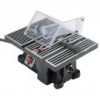Harbor Freight Tools 68829 User Manual - Page 5
Safety, Operation, Maintenance, Setup
 |
View all Harbor Freight Tools 68829 manuals
Add to My Manuals
Save this manual to your list of manuals |
Page 5 highlights
Safety Setup 8. Make sure the workpiece is supported 10. As noted previously, Kickback is a at all times while sawing. Use a sudden reaction to a pinched, bound, or roller stand (not provided) with misaligned blade, causing an uncontrolled larger workpieces if necessary. workpiece to lift up and out of the saw toward 9. To properly understand all safety warnings, be familiar with the following safety terms and equipment: the operator. Kickback is usually a result of tool misuse and can be limited or avoided by following the precautions below: a. Featherboard - A block with "fingers" that hold the workpiece against the fence while sawing. b. Through-sawing - A cut made from one side of a board to the opposite side, without stopping. c. Ripcut or Ripping - A cut made parallel to (along with) the grain of the wood. d. Crosscut or Crosscutting A cut made perpendicular (at a 90° angle) to the grain of the wood. • Fence must be completely parallel to the saw blade. • Workpiece must be free from flaws (such as loose knots) and from foreign objects (such as nails and screws). • Support large workpieces along their entire length. Large workpieces tend to bend, grabbing the blade. • Do not use a dull, pitch-covered, or damaged blade. e. Push-stick - A narrow strip of wood or other soft material with a notch cut into one end • Do not use fence as a guide when crosscutting. and which is used to push short pieces of material through saws. It provides a safe distance between the hands and the cutting tool. Must be narrower than the cut width to prevent contact with the blade. f. Freehand - Feeding a workpiece through the saw without using a fence or guided support to guide it. NOT A SAFE METHOD. g. Kerf - The gap made by the saw in the workpiece. • Do not ripcut a twisted or warped workpiece, or workpiece without straight edge to guide along fence. • Maintain control of the workpiece. Do not allow the workpiece to rest against the moving blade without holding onto it. • If the blade binds or a cut is interrupted, turn off the power switch and hold the workpiece still until the blade stops. Correct the cause of blade binding before proceeding. h. Kickback - A sudden reaction to a pinched, bound, or misaligned blade, causing an uncontrolled workpiece to lift up and out of the saw toward the operator. • Before continuing an unfinished cut, center the blade in the pre-cut kerf and check that the saw teeth are not engaged into the workpiece before turning on the saw. i. Spreader - A metal plate that follows the saw blade to keep the kerf (gap) from closing on the saw blade. • Push the wood stock past the blade prior to release. Spreaders, except riving knives, must 11. Check guards for proper operation with saw be aligned to the blade after blade disconnected from power before each use. adjustment to prevent binding. Do not disable any guard. Do not operate j. Riving Knife - A spreader mounted on the same mechanism as the blade. Generally more effective than simple spreaders. saw if any movable guard does not move freely and close instantly. Make sure any movable guard does not touch the blade in all angles, depths of cut, and positions. 12. Keep the guard in place while through‑sawing. Verify that the spreader lines up with the blade to prevent binding. 13. Construct an appropriate Push Stick out of wood according to the guidelines on the following page. Operation Maintenance Item 68829 For technical questions, please call 1-800-444-3353. Page 5














